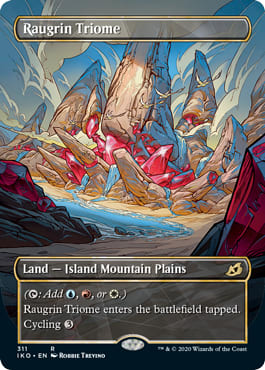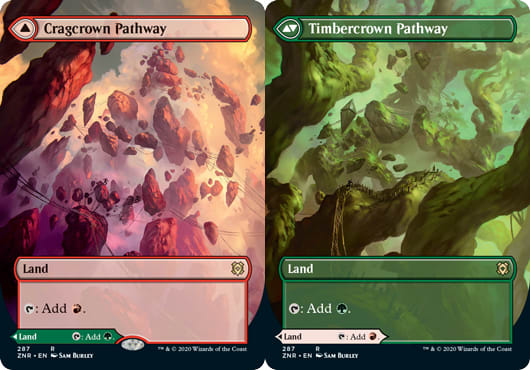Understanding the range of Magic's dual lands in the most popular formats is critical to successful deck-building. Outside of mono-colored decks, Magic's dual lands ensure you can cast your most powerful cards, at the right time, regardless of your decks' potential color combinations. This article delves into the most important and most played dual land cycles across Magic's paper formats, including Commander, Modern, Standard, and Pioneer. We'll review the power of fetchable dual lands, the best dual lands in smaller formats, and which ones will stick around after the upcoming Standard rotation.
Dual Lands in Commander
Commander benefits from having access to the most types of dual lands legal in the format, many of which can be strategically playable since Commander decks often play more than 30 lands but are limited to one copy per card.
If you can afford them, the cycle of original dual lands that date back to Alpha are legal here and a great place to start. Cards like Volcanic Island and Bayou might seem expensive now, but thanks to recent reprints in Magic's 30th Anniversary Edition, versions of these cards are a few hundred dollars cheaper than the prior cheapest Revised versions.
In lieu of these highly powerful lands that enter untapped, produce two colors of mana, and can be retrieved off a fetch land, the Ravnica shock lands are a reasonable and much more affordable replacement. The only functional difference between shocks and original duals is the two life you pay for a shock to enter the battlefield untapped. But when starting at 40 life, paying that extra two life for a Blood Crypt is typically negligible.
Perhaps the most unique cycle of Commander dual lands is known as the Battlebond lands. Cards like Morphic Pool and Vault of Champions were first introduced in 2018's Battlebond release, produce two colors of mana, and enter untapped if you have at least two opponents - which is basically a given in any Commander game.
Dual Lands in Modern
Similar to Commander, the most popular lands in Modern are defined by the availability of fetch lands in the format. Though fetches like Scalding Tarn and Windswept Heath don't technically tap for mana, they effectively represent any color of mana since they can be used to get a variety of fetchable dual lands or even triomes from your deck, based on the color requirements of your strategy.
While the triomes might not fit the strictest definition of dual lands, since their introduction in Ikoria: Lair of Behemoths in 2020, they have ushered a new era of three and four color decks in Modern. While Ikoria included five of these lands, including Raugrin Triome and Ketria Triome, the cycle was complete a couple years later when Streets of New Capenna came with the remaining lands, like Xander's Lounge and Jetmir's Garden.
Not only do they produce three colors of mana, based on the cards' designated land types, but they come with an added safety valve in their cycling ability. So when you draw one too many, you can convert it into another card, even at instant speed.
One of the newest dual land cycles to become an instant staple in Modern, again due to the presence of fetches, are the surveil lands from Murders at Karlov Manor. Since these lands feature basic land types, fetching them to manipulate the top of your deck makes up for the apparent downside of only entering tapped. Apart from the potential benefits of cleaning up a potential bad draw, they also offer some added synergies for graveyard-centric decks such as reanimator strategies, or in the case of Elegant Parlor, feeding the escape cost of the new Phlage decks.
Dual Lands in Standard
With the upcoming Standard rotation following Bloomburrow's release on August 2, Standard mana bases are going to shift overnight when Innistrad's slow lands and Streets of New Capenna triomes leave the format.
Even though Bloomburrow itself doesn't offer a new cycle of dual lands, the remaining Standard-legal sets offer a ton of dual land types to ensure all the color combinations will remain supported.
Between Outlaws of Thunder Junction and Phyrexia: All Will Be One, all ten color pairs will continue to have fast lands, such as Spirebluff Canal and Seachrome Coast. Meanwhile, The Lost Caverns of Ixalan and Wilds of Eldraine also offer two color creature lands in every creature type, for when you run out of creatures and need to win with a Restless Anchorage. Plus the aforementioned surveil lands from Murders at Karlov Manor remain Standard legal too.
Dual Lands in Pioneer
Pioneer provides an interesting mix of dual lands, featuring some of the strongest options from the huge Modern cardpool, but without the fetch lands that ensure all colors are available on demand. In result, Pioneer decks can have very efficient mana in every two-color combination, but expanding into three or more colors can be unreliable and slow.
While shock lands and fast lands remain staples in Pioneer decks, old school pain lands like Battlefield Forge and Sulfurous Springs enjoy their place in the format, too.
However, one of the format's most unique dual land cycles are the Pathway lands from Zendikar Rising and Kaldheim. Unlike other duals, Pathways are double faced cards where each side taps for a different color of mana. So, although they come in untapped and can help fix a deck's mana base, when you play a Cragcrown Pathway // Timbercrown Pathway for example, you have to decide which of the two colors you want it to produce for the rest of the game.
Wrapping Up
Even when it seems like every new Magic release introduces another selection of dual lands, not all duals are created equal. Lands that come in tapped can lead to a difficult tempo loss, and understanding the best dual lands for your favorite decks can be the difference between winning and losing. Given their usefulness and power level, dual lands can certainly vary in price. But thanks to recent reprints and the sheer number of options, every color combination has two or three color mana sources available for any budget.









































